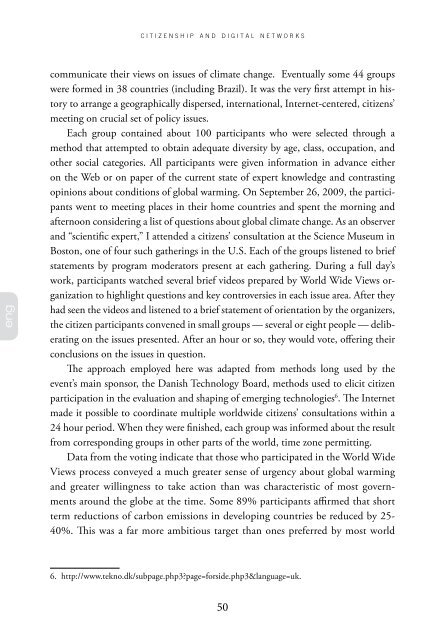Sergio Amadeu da Silveira - Cidadania e Redes Digitais
Sergio Amadeu da Silveira - Cidadania e Redes Digitais
Sergio Amadeu da Silveira - Cidadania e Redes Digitais
Create successful ePaper yourself
Turn your PDF publications into a flip-book with our unique Google optimized e-Paper software.
eng<br />
c i t i z e n s h i p a n d d i g i t a l n e t w o r k s<br />
communicate their views on issues of climate change. Eventually some 44 groups<br />
were formed in 38 countries (including Brazil). It was the very first attempt in history<br />
to arrange a geographically dispersed, international, Internet-centered, citizens’<br />
meeting on crucial set of policy issues.<br />
Each group contained about 100 participants who were selected through a<br />
method that attempted to obtain adequate diversity by age, class, occupation, and<br />
other social categories. All participants were given information in advance either<br />
on the Web or on paper of the current state of expert knowledge and contrasting<br />
opinions about conditions of global warming. On September 26, 2009, the participants<br />
went to meeting places in their home countries and spent the morning and<br />
afternoon considering a list of questions about global climate change. As an observer<br />
and “scientific expert,” I attended a citizens’ consultation at the Science Museum in<br />
Boston, one of four such gatherings in the U.S. Each of the groups listened to brief<br />
statements by program moderators present at each gathering. During a full <strong>da</strong>y’s<br />
work, participants watched several brief videos prepared by World Wide Views organization<br />
to highlight questions and key controversies in each issue area. After they<br />
had seen the videos and listened to a brief statement of orientation by the organizers,<br />
the citizen participants convened in small groups — several or eight people — deliberating<br />
on the issues presented. After an hour or so, they would vote, offering their<br />
conclusions on the issues in question.<br />
The approach employed here was a<strong>da</strong>pted from methods long used by the<br />
event’s main sponsor, the Danish Technology Board, methods used to elicit citizen<br />
participation in the evaluation and shaping of emerging technologies 6 . The Internet<br />
made it possible to coordinate multiple worldwide citizens’ consultations within a<br />
24 hour period. When they were finished, each group was informed about the result<br />
from corresponding groups in other parts of the world, time zone permitting.<br />
Data from the voting indicate that those who participated in the World Wide<br />
Views process conveyed a much greater sense of urgency about global warming<br />
and greater willingness to take action than was characteristic of most governments<br />
around the globe at the time. Some 89% participants affirmed that short<br />
term reductions of carbon emissions in developing countries be reduced by 25-<br />
40%. This was a far more ambitious target than ones preferred by most world<br />
6. http://www.tekno.dk/subpage.php3?page=forside.php3&language=uk.<br />
50


